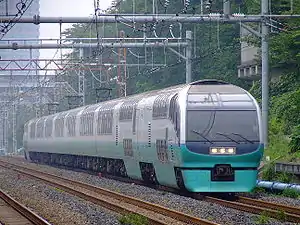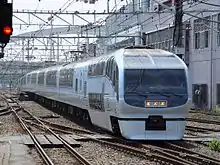251 series
The 251 series (251系) was a DC electric multiple unit (EMU) train type operated by East Japan Railway Company (JR East) on Tokaido Main Line Super View Odoriko limited express services in Japan between April 1990[1] and March 2020.
| 251 series | |
|---|---|
 A 251 series train on a Tōkaidō Main Line Super View Odoriko service in July 2007 | |
| In service | April 1990 – March 2020 |
| Manufacturer | Kawasaki Heavy Industries and Kinki Sharyo |
| Entered service | 28 April 1990 |
| Refurbished | 2002–2004 |
| Scrapped | 2020 |
| Number built | 40 vehicles (4 sets) |
| Number in service | None |
| Successor | E261 series |
| Formation | 10 cars per trainset |
| Fleet numbers | RE1–4 |
| Operator(s) | JR East |
| Depot(s) | Ōmiya |
| Line(s) served | Tokaido Main Line |
| Specifications | |
| Car body construction | Steel |
| Car length | 20,000 mm (65 ft 7 in) |
| Width | 2,950 mm (9 ft 8 in) |
| Doors | Plug doors: 1 per side |
| Maximum speed | 120 km/h (75 mph) |
| Traction system | Resistor control + field system superimposed field excitation control |
| Electric system(s) | 1,500 V DC overhead catenary |
| Safety system(s) | ATS-SN, ATS-P |
| Track gauge | 1,067 mm (3 ft 6 in) |
Operations
The 251 series sets were primarily used on Super View Odoriko limited express services from Tokyo, Ikebukuro, and Shinjuku to Izukyu Shimoda.[2]
Since the 13 March 2004 timetable revision, 251 series sets were also used on the weekday morning Ohayō Liner Shinjuku 26 and weekday evening Home Liner Odawara 23 services.[2]
Formation
The four sets, numbered RE1 to RE4 and based at Ōmiya Depot in Tokyo, were formed as follows, with car 1 at the Izukyū-Shimoda end, and car 10 at the Tokyo and Shinjuku end.[2]
| Car No. | 1 | 2 | 3 | 4 | 5 | 6 | 7 | 8 | 9 | 10 |
|---|---|---|---|---|---|---|---|---|---|---|
| Designation | Tscd' | Tsd | M' | M1 | M'1 | M | M' | M | T | Tcd |
| Numbering | KuRo 250 | SaRo 251 | MoHa 250 | MoHa 251-100 | MoHa 250-100 | MoHa 251 | MoHa 250 | MoHa 251 | SaHa 251 | KuHa 251 |
Cars 4, 6, and 8 were each fitted with one PS27 scissors type pantograph.[2]
 KuRo 250 (car 1)
KuRo 250 (car 1) SaRo 251 (car 2)
SaRo 251 (car 2) MoHa 250 (car 3)
MoHa 250 (car 3) MoHa 250-100 (car 5)
MoHa 250-100 (car 5) MoHa 251 (car 8)
MoHa 251 (car 8) SaHa 251 (car 9)
SaHa 251 (car 9) KuHa 251 (car 10)
KuHa 251 (car 10)
 A PS27 pantograph on a 251 series set in August 2016
A PS27 pantograph on a 251 series set in August 2016
Interior
 Children's play area on the lower deck of a KuHa 251 car
Children's play area on the lower deck of a KuHa 251 car
History

Built by Kawasaki Heavy Industries and Kinki Sharyo,[3] the first two sets were introduced from 28 April 1990.[4] These were followed by two more sets in 1992.[1]
The 251 series was awarded the 1991 Laurel Prize, presented annually by the Japan Railfan Club.[5] A formal presentation ceremony was held at Shinagawa Station in Tokyo on 1 March 1992.[6]
The fleet underwent a programme of refurbishment between December 2002 and March 2004, which included the addition of new seating, and repainting the sets into a new colour scheme.[2]
Withdrawal
From the start of the revised timetable on 14 March 2020, the 251 series sets were replaced by new E261 series sets on services between Tokyo and Izukyu-Shimoda, with the Super View Odoriko brand being replaced by new ultra-deluxe Saphir Odoriko services. The last 251 series Super View Odoriko limited express run took place on 13 March 2020.
References
- Jēāru zensharyō handobukku: Rail Magazine 2009 JR全車輌ハンドブック2009 [JR Rolling Stock Handbook 2009]. Japan: Neko Publishing. 2009. ISBN 978-4-7770-0836-0.
- JR電車編成表 2011夏 [JR EMU Formations - Summer 2011]. Japan: Kotsu Shimbunsha. May 2010. p. 79. ISBN 978-4-330-21211-1.
- Saka, Masahiro (March 2014). JR第1世代の車両・現況と概要 [JR 1st-generation rolling stock: Current situation and overview]. Tetsudō Daiya Jōhō Magazine (in Japanese). 43 (359): 22.
- JR特急10年の歩み [10 Years of JR Limited Express Trains] (in Japanese). Japan: Kousai Shuppansha. May 1997. pp. 49–50. ISBN 978-4-330-45697-3.
- ブルーリボン賞・ローレル賞 選定車両一覧 [Blue Ribbon Award & Laurel Prize Winner List]. jrc.gr.jp (in Japanese). Japan: Japan Railfan Club. 29 May 2012. Archived from the original on 26 October 2010. Retrieved 29 December 2012.
- 251系ローレル賞受賞 [251 series awarded Laurel Prize]. Japan Railfan Magazine. 32 (373): 34. February 2013.
External links
| Wikimedia Commons has media related to 251 series. |
- JR East 251 series Super View Odoriko (in Japanese)